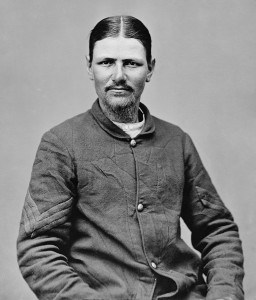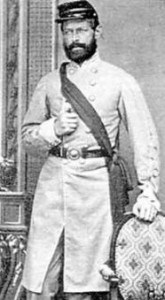
In 1865, Lew Wallace played a role in two important trials at the conclusion of the Civil War. He served as a judge on the tribunal handling the case against the Lincoln Conspirators. In addition, he served as the lead judge in the trial of Commander Henry Wirz of Andersonville. As it turned out, Wallace was not the only person to be associated with both Andersonville and the Lincoln Conspirators. A fellow named Thomas P. “Boston” Corbett was also a player in both of these episodes of the Civil War. However, he played a very different role from Lew’s.
Early Life
Born in England in 1832, Corbett immigrated to America with his family and took up the trade of hat making in Troy, New York. In the 19th century, two of the most dangerous occupations were the silvering of mirrors and hat making. The amount of mercury used in manufacturing the products made them incredibly dangerous. Men who worked in these professions could not expect to live long lives. Because of the effects of the mercury, insanity commonly troubled these men. Lewis Carroll used this trope to great effect with the Mad Hatter from Alice in Wonderland.
Corbett’s young wife died in childbirth and he moved to Boston where he continued his work as a hatter. The effects of his profession may have been beginning to manifest themselves. After his move to Boston, he changed his name from Thomas to “Boston,” grew his hair very long to better emulate Jesus, and in 1858 took the drastic step of castrating himself with a pair of scissors in an effort to avoid the temptation of prostitutes. Before seeking medical treatment for his self inflicted surgery, he ate a meal and attended a prayer meeting.
Private Corbett, a Prisoner of War
In April 1861, at the outbreak of the Civil War, Corbett joined the army as a private in the New York militia. When this enlistment expired he later reenlisted in September of 1863. He was captured in Culpeper, Virginia, in June of 1864. Corbett spent the next five months at the prisoner of war camp in Andersonville. He was exchanged in late 1864. At that time, Corbett returned to his company with a promotion to sergeant. Because he spent time at Andersonville, he testified in Henry Wirz’s trial. Lew Wallace would have certainly taken interest in Corbett’s testimony.

Corbett and John Wilkes Booth
In April of 1865, Corbett was a member of the 16th New York Cavalry Regiment and a part of the troops assembled for the manhunt for John Wilkes Booth. On April 26th, Corbett and his regiment surrounded Booth and Davy Herold in a barn on the farm of Richard Garrett. After the barn caught fire, Herold surrendered. However, Booth did not. Corbett, stationed near a crack in the barn wall, claimed he saw Booth raise a carbine. In response, Corbett shot and mortally wounded Lincoln’s assassin.
Secretary of War Edwin Stanton wanted Booth taken alive. As a result, Corbett was arrested for violating orders. Stanton quickly dismissed the charges, stating: “The rebel is dead. The patriot lives.” Stories surrounding the death of Booth circulated. Corbett told people he fired the fatal shot because “Providence directed me.” Again, Wallace must have known about Corbett’s involvement in Booth’s death. Corbett went on to collect his share of the reward money for the capture of Booth.
Life Post-War
After his discharge from the military he resumed making hats; first in Boston, then in Connecticut, and finally in New Jersey. His mental deterioration continued. In 1875, he threatened a group of men with a firearm at a soldier’s reunion.
In 1878, he moved to Kansas. As a result of his fame, he was asked to serve as door keeper for the House of Representatives in 1887. Within a few months he heard someone in the House make disparaging remarks about the prayer that had been offered. Again, Corbett threatened a group of men, brandishing a revolver in the chambers. Authorities arrested him and sent him to the Topeka Asylum for the Insane. Unfortunately, he soon escaped.
Corbett told a friend that he planned to go to Mexico. However, many people believe he headed to Concordia, Kansas. There, rumor said, he lived in a dugout—basically a hole in the ground—before heading north to Minnesota. There perhaps he lived in a small cabin in the woods near Hinckley. His fate is unknown, but historians believe he died in the Great Hinckley Fire of 1894.
Lew Wallace and Boston Corbett lived decidedly different lives. It’s intriguing to note how their lives crossed at two particular moments in American legal history. Lew Wallace is remembered for many accomplishments and experiences. However, Boston Corbett is generally remembered for the two episodes in his life where his path crossed Lew’s.
Thank you to Sam Andre for research assistance.